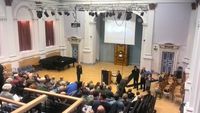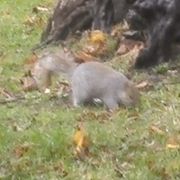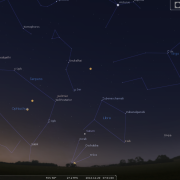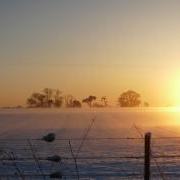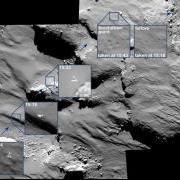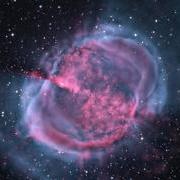Welcome to the WDAS monthly newsletter for December 2014: a digest of the month's latest contributions to our website. Below you'll find Society News, Sky Notes and In-Focus articles printed in full. There's also future events, and trailers for other articles which appear in full on the website - just a click away!
On the website you'll also be able to comment on articles, and if you'd like to play an editorial role in creating new content, just let us know!
If you don't see images in this e-mail, look for a setting in your browser or e-mail reader to display them; and if you have any other problems reading the newsletter please let us know the browser or e-mail program you're using, and we'll see if we can fix it.
Society News
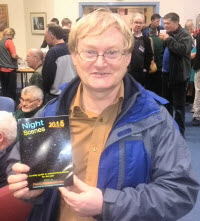 We caught up with Paul Money at Astromeet, and now have in our possession 20 copies of Night Scenes 2015... and it’s fair to say there’s quite a lot to look forward to next year.
We caught up with Paul Money at Astromeet, and now have in our possession 20 copies of Night Scenes 2015... and it’s fair to say there’s quite a lot to look forward to next year.
So for an in depth preview of celestial events next year reserve your copy now. First come, first serve, as usual, Booklets are priced at £4 for members and £6 for non members.
 You have the snazzy new-style newsletter; and now here comes ther reminder to WDAS Members about subscriptions for 2015, which are now due for renewal and will be held at the current inflation-busting levels as last year.
You have the snazzy new-style newsletter; and now here comes ther reminder to WDAS Members about subscriptions for 2015, which are now due for renewal and will be held at the current inflation-busting levels as last year.
So subs for the full year are just:
- £12 for Adults
- £5 for Under-16s
+ Night Scenes are £4 for members
You can bring subs along to the WDAS monthly meetings in December, January or February at the very latest.
If you cannot make the meetings, cheques are welcome. Please make them payable to;- Whitby & District Astronomical Society, and address them to Mark Dawson - 33 laburnum Grove, Whitby. YO21 1HZ.
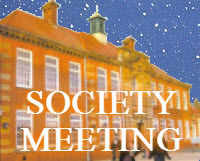 Don't forget the December 2014 WDAS meeting.
Don't forget the December 2014 WDAS meeting.
This month:
 Mark gives us an in-depth look at hot star cluster The Pleiades
Mark gives us an in-depth look at hot star cluster The Pleiades-
 Andi gives an update of Astro-News, including the Rosetta/Philae mission so far - with 3D images and animations, no less! (3D glasses supplied)
Andi gives an update of Astro-News, including the Rosetta/Philae mission so far - with 3D images and animations, no less! (3D glasses supplied) -
 As well as a tour of the Christmas sky, now, and then;
As well as a tour of the Christmas sky, now, and then;
and Society business for December.
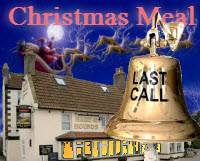 If you still wish to come along to the Christmas Meal (and we believe there are a few who do) please let Mark know before December 4th, along with your menu choices.
If you still wish to come along to the Christmas Meal (and we believe there are a few who do) please let Mark know before December 4th, along with your menu choices.
As of going to press there are 10 confirmed for the Christmas meal: Andi, Andy L, Ian D, John T and Sue, Mark, Keith, Phil, Rosemary and Victor (all with menu choices).
The date is Dec 12th for around 7:15pm. It has been provisionally booked for up to fifteen. We shall sort out transport ideas at the December monthly meeting.
Preparing to start the lecture "When
Galaxies Collide" (Click image for full
-size view, and try to spot Lee, Keith
and John. Where's Mark? Probably
buying lenses or raffle tickes!)
At one point it could have run to three cars, but in the end five WDAS members made the journey over to Leeds squeezing into just one - Andi's car - for Astromeet 2014.
The slightly 'quicker detour route' around Pickering proved 'deer-less' this year, much to our disappointment and arrival at Leeds university was bang on 09:40h - as per usual.
Mark signed everyone in: Andi, John L, Keith and Lee and we headed for the venue rooms to quickly peruse the trade stalls and meet up with Mike (Marks mate). Mark was first to snap up a Barlow lens and 32mm plossle eyepiece, before purchasing another Barlow lens and 26mm Plossle eyepiece. Had he gone mad? (Well, some would argue....) Aahh no, just a shopping list for other people. And they got change as well!
Inside, Alan's talk on Edmond Halley;
while just outside, a squirrel prepares
for the Winter Solstice.
After are usual foray over to the Leeds Univ refectory complex for a spot of lunch, we made contact with Paul Money who had come up to Leeds for the afternoon lectures and to exchange copies of Night Scenes with various society representatives or individuals. Transactions completed it was time for the afternoon session. The raffle draw was conducted before Alan Chapman’s talk (as is customary) but for once WDAS members were left empty handed - frustratingly just a number out either way on several accounts.
Keep reading for the first of Mark's notes on the lectures...
Sky Notes
In this month's Sky Notes:
- Planetary Skylights
- Meteor Activity
- Winter Solstice
- Philae: Touchdown... Touchdown... touchdown.
- November 2014 Sky Charts
Planetary Skylights
 Mars stubbornly lingers in the evening sky above the WSW horizon and doesn’t actually set until after 7pm. telescopically, it’s a case of ‘move along, nothing to see’, the disc being very small, but at least you can point it out to friends. The moon lies close by on the 24th & 25th.
Mars stubbornly lingers in the evening sky above the WSW horizon and doesn’t actually set until after 7pm. telescopically, it’s a case of ‘move along, nothing to see’, the disc being very small, but at least you can point it out to friends. The moon lies close by on the 24th & 25th.
 Jupiter is now rising well before midnight, a conspicuous presence across in the east by 9:30pm at the start of December and 8pm at the end, by which time it is well placed for observation. Telescopically, Jupiter is a wonderful spectacle with its attendant major moons and 'banded' disk, a real Christmas treat. After midnight Jupiter will be riding high to the south. The king of the planets actually resides just ahead of the ‘sickle asterism’ in Leo and not far from Regulus, its chief star. The moon lies near Jupiter and Regulus on the 9th.
Jupiter is now rising well before midnight, a conspicuous presence across in the east by 9:30pm at the start of December and 8pm at the end, by which time it is well placed for observation. Telescopically, Jupiter is a wonderful spectacle with its attendant major moons and 'banded' disk, a real Christmas treat. After midnight Jupiter will be riding high to the south. The king of the planets actually resides just ahead of the ‘sickle asterism’ in Leo and not far from Regulus, its chief star. The moon lies near Jupiter and Regulus on the 9th.

 During the last week of December first brilliant Venus and then elusive Mercury crawl up into the evening sky. Look for them low to the WSW horizon 45 minutes after sunset. Both will be better placed as we head into the New Year.
During the last week of December first brilliant Venus and then elusive Mercury crawl up into the evening sky. Look for them low to the WSW horizon 45 minutes after sunset. Both will be better placed as we head into the New Year.
 Finally Saturn returns to the early morning sky by mid December and is visible low to the ESE by 6:30am. The moon passes close by on the 19th and 20th. An early morning Christmas treat!
Finally Saturn returns to the early morning sky by mid December and is visible low to the ESE by 6:30am. The moon passes close by on the 19th and 20th. An early morning Christmas treat!
Meteor Activity

Meteor activity reaches a peak at this time of year and given clear skies the chance of spotting a shooting star or two should be quite high.
Considered now to be the most prolific annual meteor shower, the Geminids are active from December 7-16th, reaching a peak on December 14th. Unlike the majority of meteor showers, which are associated with comet debris, Geminids stem from debris shed by a strange object that may be a dead comet or small asteroid called Phaethon. This object passes within 10 million miles of the Sun and over time has deposited material over great swathes of the inner solar system. However it is only within the last 100 years that Geminid activity has increased to the levels recorded today with Earth passing through a much denser debris strand, a situation that will only last another 100 years!
The shower radiant lies close to Castor, the upper most of the 'twin' stars in Gemini visible in the east by 9pm. Under ideal conditions the Zenith Hourly Rate (ZHR) can reach well over 100, however observed rates are always substantially lower than this, so expect around 40 per hour during the early morning hours of the 14th. Really bright Geminids can sometimes appear green or orange in hue. Later in the month the Ursids (active Dec 17-25th) peak on Dec 22/23rd with hourly rates of 8-12 normal. Occasionally Ursids produce strong outbursts. The radiant lies close to the Great Bear.
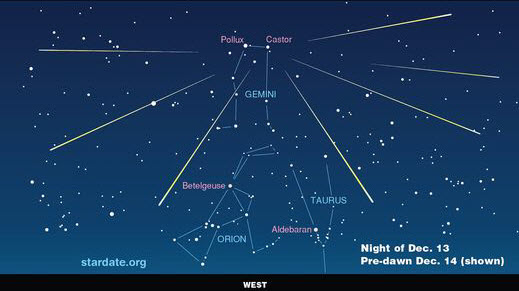
The Winter Solstice
Winter Solstice in Highlands
(Click image for full-size view)
We'd like to feature your photo:
please send them to us!
The Sun reaches its lowest position in the sky on December 21st this year; the date of the winter solstice, by which time the Sun arcs little more than 12 degrees above S horizon at local noon from our latitude.
With the northern hemisphere tilted away from the Sun, useful daylight then amounts to just 7½ hrs, the shortest day. Latest sunrise and earliest sunset do not however occur on the 21st. The Sun rises latest near the end of December (27 or 28th) and sets earliest mid-month (15th or 16th).
Astronomically speaking the winter solstice also marks the first day of winter in the northern hemisphere, but in a few weeks, daylight will once again start to lengthen in duration. Now that is cause for celebration! What shall we call it...mmm!.
Philae: Touchdown.... Touchdown... touchdown
Where did Philae get to?, OSIRIS
instrument spots Philae drifting
across the comet (Click image
for full-size view)
It’s been quite a while since a robotic lander mission caused such huge interest, even excitement amongst the general public, but the fortunes of Philae at comet 67P certainly did just that.
This was a drama played out over 300 million miles away with Ups and Downs a-plenty (certainly Philae experienced a few) and left us on the edge of our seats, with Philae near the edge of somewhere!
Approximately 8o% of the scientific program was completed, the results of which are still being analysed. What we do know is that Philae is now in hibernation mode, starved of sunlight to power the solar panels. Perhaps, as the comet heads into the inner solar system its orientation will alter, allowing sunlight to illuminate the location of Philae’s final resting place. We shall see in the coming months. I have a hunch the ride is not yet over!
For the latest on where Philae may finally have landed, mision news, science and even 3D images and movie-clips of the comet, join us on Tuesday 2nd December at 19:30h - 3D glasses supplied!
December 2014 Sky Charts
Click each image to see a full-size Sky Chart:
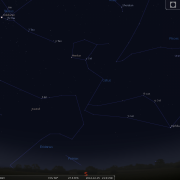 |
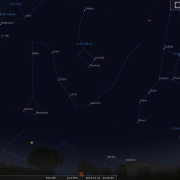 |
| Looking South Mid December - 21:00h |
Looking North |
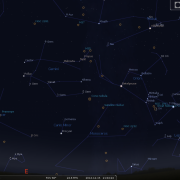 |
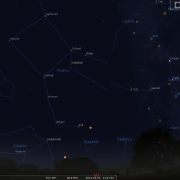 |
| Looking South-East Mid December - 21:00h |
Looking West Mid December - 19:45h |
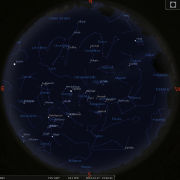 |
|
| Overview Mid-December - 21:00h |
Image Credits:
- Planets and Comets where not otherwise mentioned: NASA
- Position of Geminids: stardate.org
- Winter Solstice: © Sylvia Duckworth, licensed for reuse under this Creative Commons Licence
- Rosetta Mission: ESA
- Sky Charts: Stellarium Software
In the News
The European Space Agency (ESA) has released three short videos about the Rosetta Mission: one focusing on the scientific objectives, another updating their mission summary, and this one - the latest in the children's animations, tells the story of the Philae lander preparing to descend to the surface of Comet 67P Churyumov-Gerasimenko.
See the full article for all three videos, and don't forget the landing itself on the 12th of November.
It was a day full of excitement and trepidation, as the drama of the Philae Lander's despatch from the Rosetta's satellite took place, and Philae drifted in super-weak gravity towards the surface on a 7-hour journey to Comet 67P/Churyumov-Gerasimenko.
It was a day which almost didn't happen, as overnight preparations revealed a malfunction in the thruster which was to press Philae to the ground immediately on landing while harpoons tethered it to the comet surface were fired. But the decision was taken to go ahead, and at about 08:30h GMT Philae successfully separated from Rosetta and began its descent.
The landing was confirmed at around 16:05h GMT and verified a few minutes later. But all was not as it seemed...
His lecture to Astromeet was ‘The formation of planetary nebulae’.
M27: Dumbell Nebula
First Planetary Nebula discovered
by Charles Messier in 1764
(Click image for full-size view)
A very apt, timely lecture, given that it’s the 250th anniversary of the first recorded observation of a planetary nebula by Charles Messier – M27; the Dumbbell nebula, and as Albert noted, even then the view would be different to how it looks today, such is the evolution of these beautiful objects.
The term ‘Planetary nebula’ was actually coined by William Herschel, discoverer of Uranus. Through telescopes of the day planetary nebulae somewhat resembled the giant planets like Uranus, At first Herschel thought the objects were stars surrounded by material that was condensing into planets rather than what is known to be evidence of dead stars that have incinerated any orbiting planets!.
The true nature of planetary nebulae was unknown until the first spectroscopic observations were made in the mid-19th century. Planetary nebulae came to be understood as a final stage of stellar evolution. Spectroscopic observations show that all planetary nebulae are expanding. This led to the idea that planetary nebulae were caused by a star's outer layers being thrown into space at the end of its life...
 In time honoured fashion the final lecture was delivered by Dr Alan Chapman. His subject this year was Edmond Halley, and as we soon learned Halley was not just an exceptional astronomer, his experiments, observations and research extended into many varied fields of science and professions, including fledgling scientific concepts and ideas.
In time honoured fashion the final lecture was delivered by Dr Alan Chapman. His subject this year was Edmond Halley, and as we soon learned Halley was not just an exceptional astronomer, his experiments, observations and research extended into many varied fields of science and professions, including fledgling scientific concepts and ideas.
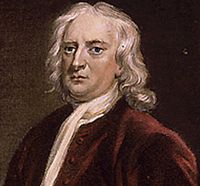 Halley was born in Shoreditch on the 8th November 1656. His father, Edmond Halley Sr. came from a Derbyshire family and was a wealthy soap-maker in London. Apart from the soap business, the Halley’s had plenty of properties in London. Even though, they lost some of their assets during the 'Great Fire of London' in 1666, it hardly affected their financial status; as Alan stated; ‘they were quite well off’.
Halley was born in Shoreditch on the 8th November 1656. His father, Edmond Halley Sr. came from a Derbyshire family and was a wealthy soap-maker in London. Apart from the soap business, the Halley’s had plenty of properties in London. Even though, they lost some of their assets during the 'Great Fire of London' in 1666, it hardly affected their financial status; as Alan stated; ‘they were quite well off’.
As a child Halley was very interested in mathematics and received private tuitions at home till he was admitted to St. Pauls School where he excelled in everything he did and became the captain of the school at the age of just 15. His father had already kitted out Edmond with all the necessary astronomical equipment required and in 1673 Halley went to Queens College;Oxford and whilst an undergraduate, he published papers on the Solar System and sunspots. However, he left the college in 1675 without completing his degree and started working for John Flamsteed who was the ‘Astronomer Royal’ at the Greenwich Observatory. Among other things, Halley had the job of assigning what is now called Flamsteed numbers to stars. ‘Halley was starting to make a name for himself’...
Events
 Observe the night sky with us at the Bruce Observatory, Whitby School
Observe the night sky with us at the Bruce Observatory, Whitby School
Observing Nights are held weather permitting: check for a relatively clear sky before leaving home. If in doubt, Mark can be reached on 07886069339
Please note the college drive gate is now operated via a electronic key code - so anyone wishing to attend must be at the car park at the top of the drive by 19:00hrs - unless an arrival time has been arranged with Mark/Keith.
 Observe the night sky with us at the Bruce Observatory, Whitby School
Observe the night sky with us at the Bruce Observatory, Whitby School
Observing Nights are held weather permitting: check for a relatively clear sky before leaving home. If in doubt, Mark can be reached on 07886069339
Please note the college drive gate is now operated via a electronic key code - so anyone wishing to attend must be at the car park at the top of the drive by 19:00hrs - unless an arrival time has been arranged with Mark/Keith.
 Observe the night sky with us at the Bruce Observatory, Whitby School
Observe the night sky with us at the Bruce Observatory, Whitby School
Observing Nights are held weather permitting: check for a relatively clear sky before leaving home. If in doubt, Mark can be reached on 07886069339
Please note the college drive gate is now operated via a electronic key code - so anyone wishing to attend must be at the car park at the top of the drive by 19:00hrs - unless an arrival time has been arranged with Mark/Keith.
 Observe the night sky with us at the Bruce Observatory, Whitby School
Observe the night sky with us at the Bruce Observatory, Whitby School
Observing Nights are held weather permitting: check for a relatively clear sky before leaving home. If in doubt, Mark can be reached on 07886069339
Please note the college drive gate is now operated via a electronic key code - so anyone wishing to attend must be at the car park at the top of the drive by 19:00hrs - unless an arrival time has been arranged with Mark/Keith.
 Whitby School - Room H1.
Whitby School - Room H1.
In Members' monthly meetings we usually take a tour of the night sky for the coming month using the Planetarium program. Have talks and presentations on various topics of astronomy/space etc, and discuss future events etc. New members welcome.
 Observe the night sky with us at the Bruce Observatory, Whitby School
Observe the night sky with us at the Bruce Observatory, Whitby School
Observing Nights are held weather permitting: check for a relatively clear sky before leaving home. If in doubt, Mark can be reached on 07886069339
Please note the college drive gate is now operated via a electronic key code - so anyone wishing to attend must be at the car park at the top of the drive by 19:00hrs - unless an arrival time has been arranged with Mark/Keith.
 Observe the night sky with us at the Bruce Observatory, Whitby School
Observe the night sky with us at the Bruce Observatory, Whitby School
Observing Nights are held weather permitting: check for a relatively clear sky before leaving home. If in doubt, Mark can be reached on 07886069339
Please note the college drive gate is now operated via a electronic key code - so anyone wishing to attend must be at the car park at the top of the drive by 19:00hrs - unless an arrival time has been arranged with Mark/Keith.

